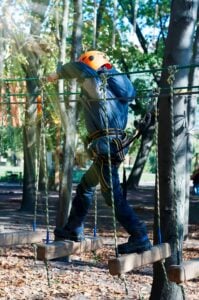Table of Contents
Explained how Tree Cabling works: Supporting Weak Branches for Lasting Health
Introduction: Protecting Trees with the Right Support
Mature trees are a beautiful and valuable part of any landscape, but even the strongest trees can develop structural weaknesses. Heavy limbs, poor branch attachments, or storm damage can put a tree’s health—and your property—at risk. This is where tree cabling comes in. By using specialized tree support systems, certified arborists can stabilize weak branches, reduce the risk of breakage, and preserve the natural beauty of your trees for decades.
If you’ve ever wondered how tree cabling works or whether your property could benefit from it, this guide from American Tree Experts in Montclair, NJ, will walk you through everything you need to know.
What Is Tree Cabling and Bracing?
Tree cabling and bracing are arboricultural techniques designed to provide structural support for trees with weak or compromised limbs.
- Cabling involves installing high-strength steel cables between major branches or tree trunks to redistribute weight and reduce movement during wind or storms.
- Bracing uses threaded steel rods to reinforce split or cracked limbs, preventing further damage.
These tree support systems help maintain stability while allowing the tree to grow naturally—offering a safer and more cost-effective solution than removal in many cases.
How Tree Cabling Works: Step-by-Step
1. Professional Tree Assessment
A certified arborist examines the tree to identify signs a tree needs cabling, such as:
- Large limbs growing horizontally
- Weak branch unions (V-shaped junctions)
- Cracks or splits in major limbs
- Past storm damage
2. Choosing the Right Cable Placement
To create effective tree limb support, arborists strategically position cables about two-thirds of the way up the canopy. This placement reduces stress on weak points without restricting natural movement.
3. Installing the Cable System
Using specialized hardware:
- Holes are drilled into strong, healthy wood.
- High-tensile steel cables are anchored securely between limbs.
- Protective sleeves prevent bark damage.
For added security, tree bracing for storm damage may be used in conjunction with cabling.
4. Long-Term Monitoring and Maintenance
A tree cabling lifespan can range from 10 to 20 years with proper care. Regular inspections ensure the system remains effective and safe.
When to Cable a Tree
Knowing when to cable a tree can prevent costly damage and extend its life. Common scenarios include:
- Storm preparation: Adding structural support for trees before hurricane or blizzard seasons.
- Historic tree preservation: Protecting large, old trees from limb failure.
- Post-damage stabilization: Repairing storm or wind damage without removal.
Tree Cabling vs. Tree Removal
While tree removal may be necessary for severely damaged or diseased trees, cabling trees for support offers a non-invasive, preservation-first approach. If your tree is healthy but has structural weaknesses, cabling is often the better, more sustainable option.
Tree Cabling Cost and Lifespan

The tree cabling cost depends on tree size, number of cables needed, and accessibility. While the initial investment may be several hundred dollars, it’s far less than the price of removal or property repairs. With routine inspections, most systems last 10–20 years.
Trust American Tree Experts for Tree Cabling Services in Montclair, NJ
If you have a valuable tree showing signs of weakness, don’t wait for a branch to fail. Professional tree cabling services can protect your landscape, improve safety, and preserve natural beauty.
Call American Tree Experts today at (973) 744-6091 or send an email at am*******************@***il.com to schedule a tree assessment.
